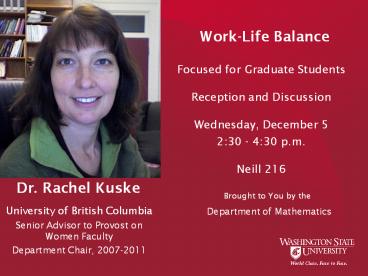Work-Life Balance - PowerPoint PPT Presentation
1 / 4
Title:
Work-Life Balance
Description:
Work-Life Balance Focused for Graduate Students Reception and Discussion Wednesday, December 5 2:30 - 4:30 p.m. Neill 216 Dr. Rachel Kuske Brought to You by the – PowerPoint PPT presentation
Number of Views:349
Avg rating:3.0/5.0
Title: Work-Life Balance
1
Work-Life Balance
- Focused for Graduate Students
- Reception and Discussion
- Wednesday, December 5
- 230 - 430 p.m.
- Neill 216
Dr. Rachel Kuske
Brought to You by the Department of Mathematics
- University of British Columbia
- Senior Advisor to Provost on Women Faculty
- Department Chair, 2007-2011
2
Dr. Rachel Kuske Background
- Professor of Mathematics, University of British
Columbia - Senior Advisor to the Provost on Women Faculty,
University of British Columbia - Canada Research Chair, Applied Mathematics, Tier
II - General Research Interests Stochastic and
nonlinear dynamics, mathematical modeling,
asymptotics and semi-analytic approximations,
mathematics in industry - Specific Research Noise sensitivity, localized
phenomena, coherence resonance with applications
in neuro-synamics, infectious diseases,
mechanical systems, hydraulic fractures,
mathematical finance
3
ColloquiumThursday, Dec. 6, 410 p.m. in Neill
5W, on Balancing Complex Dynamics Interactions
of Delays, Time Scales and Noise, Refreshments
at 300 p.m., Neill 216 presented by
Department of Mathematics
Dr. Rachel Kuske
Professor of Mathematics and Senior Advisor to
the Provost on Women Faculty at the University of
British Columbia
4
Dr. Rachel Kuske Abstract
- Balancing Complex Dynamics
- Interactions of Delays, Time Scales, and Noise
- Dynamical systems with delayed feedback often
exhibit an array of complex behaviors. These
phenomena have been studied in the context of
applications such as mechanical systems and
neural dynamics. Stochastic effects can often
change the picture dramatically, particularly if
multiple time scales are present. Recently the
mathematical techniques for canonical models have
been transferred to the study of balance in the
context of human postural sway and robotics.
While the similarities facilitate this transfer,
differences such as discontinuous control of
balance require new ideas that allow an analysis
of the interplay of nonlinearities, delays,
randomness, and piecewise smooth dynamics. A
few preliminary results and many open problems
will be discussed.































